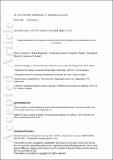Files in this item
Opposing patterns of intraspecific and interspecific differentiation in sex chromosomes and autosomes
Item metadata
| dc.contributor.author | Moran, Peter | |
| dc.contributor.author | Pascoal, Sonia | |
| dc.contributor.author | Cezard, Timothee | |
| dc.contributor.author | Risse, Judith | |
| dc.contributor.author | Ritchie, Michael G. | |
| dc.contributor.author | Bailey, Nathan W. | |
| dc.date.accessioned | 2019-06-09T23:40:01Z | |
| dc.date.available | 2019-06-09T23:40:01Z | |
| dc.date.issued | 2018-06-10 | |
| dc.identifier | 253160045 | |
| dc.identifier | 575f01a2-177c-4114-8530-44d3d9369dcc | |
| dc.identifier | 85053277264 | |
| dc.identifier | 000446838400013 | |
| dc.identifier.citation | Moran , P , Pascoal , S , Cezard , T , Risse , J , Ritchie , M G & Bailey , N W 2018 , ' Opposing patterns of intraspecific and interspecific differentiation in sex chromosomes and autosomes ' , Molecular Ecology , vol. Early view . https://doi.org/10.1111/mec.14725 | en |
| dc.identifier.issn | 0962-1083 | |
| dc.identifier.other | ORCID: /0000-0001-7913-8675/work/46761128 | |
| dc.identifier.other | ORCID: /0000-0003-3531-7756/work/60888397 | |
| dc.identifier.uri | https://hdl.handle.net/10023/17850 | |
| dc.description | Funding: Natural Environment Research Council grants to N.W.B., Grant/Award numbers: NE/G014906/1, NE/L011255/1; Orthopterists’ Society grant to P.A.M. | en |
| dc.description.abstract | Linking intraspecific and interspecific divergence is an important challenge in speciation research. X chromosomes are expected to evolve faster than autosomes and disproportionately contribute to reproductive barriers, and comparing genetic variation on X and autosomal markers within and between species can elucidate evolutionary processes that shape genome variation. We performed RADseq on a 16‐population transect of two closely‐related Australian cricket species, Teleogryllus commodus and T. oceanicus, covering allopatry and sympatry. This classic study system for sexual selection provides a rare exception to Haldane's rule, as hybrid females are sterile. We found no evidence of recent introgression, despite the fact that the species co‐exist in overlapping habitats in the wild and interbreed in the laboratory. Putative X‐linked loci showed greater differentiation between species compared to autosomal loci. However, population differentiation within species was unexpectedly lower on X‐linked markers than autosomal markers, and relative X‐to‐autosomal genetic diversity was inflated above neutral expectations. Populations of both species showed genomic signatures of recent population expansions, but these were not strong enough to account for the inflated X/A diversity. Instead, most of the excess polymorphism on the X could better be explained by sex‐biased processes that increase the relative effective population size of the X, such as interspecific variation in the strength of sexual selection among males. Taken together, the opposing patterns of diversity and differentiation at X versus autosomal loci implicate a greater role for sex‐linked genes in maintaining species boundaries in this system. | |
| dc.format.extent | 1986339 | |
| dc.language.iso | eng | |
| dc.relation.ispartof | Molecular Ecology | en |
| dc.subject | Hybridization | en |
| dc.subject | Faster-X effect | en |
| dc.subject | Population genomics | en |
| dc.subject | RAD sequencing | en |
| dc.subject | Sex chromosomes | en |
| dc.subject | Teleogryllus | en |
| dc.subject | GE Environmental Sciences | en |
| dc.subject | QH301 Biology | en |
| dc.subject | DAS | en |
| dc.subject.lcc | GE | en |
| dc.subject.lcc | QH301 | en |
| dc.title | Opposing patterns of intraspecific and interspecific differentiation in sex chromosomes and autosomes | en |
| dc.type | Journal article | en |
| dc.contributor.sponsor | NERC | en |
| dc.contributor.sponsor | NERC | en |
| dc.contributor.institution | University of St Andrews. School of Biology | en |
| dc.contributor.institution | University of St Andrews. Centre for Biological Diversity | en |
| dc.contributor.institution | University of St Andrews. Institute of Behavioural and Neural Sciences | en |
| dc.identifier.doi | 10.1111/mec.14725 | |
| dc.description.status | Peer reviewed | en |
| dc.date.embargoedUntil | 2019-06-10 | |
| dc.identifier.grantnumber | NE/G014906/1 | en |
| dc.identifier.grantnumber | NE/L011255/1 | en |
This item appears in the following Collection(s)
Items in the St Andrews Research Repository are protected by copyright, with all rights reserved, unless otherwise indicated.

